There’s always been people piercing their ears themselves or having a friend do it- the traditional sewing needle or pin and apple trope. As someone with social anxiety and a low pain tolerance (ditto for my three kids) I can relate to not wanting to be the star of the ear piercing show at the local mall. But the basic problem with doing it at home is the sterility of the method, the wherewithal to inflict pain on yourself, and getting the placement right. Eventually commercial products were developed which vastly improved on the first point, somewhat on the second, and not at all on the third.
Sleeper Earrings
First were these sadistic little torture devices known as self-piercing or “sleeper” earrings. The basic idea is they were (relatively) sharp hoops that were forced closed under tension. You’d open them up, and put them on your ears. Then they’d slowly work their way through your ears over a period of days- while you were sleeping. Being shot with a piercing gun hurts- a lot, but the actual piercing is over in a flash and then the pain dies down after an hour or two into a dull throbbing for the rest of the day These sleepers just prolonged the pain it over a period of days. It was common for the piercee to finally squeeze them closed manually just to get the pain over with.
I’ve had several inquiries as to whether these were still on the market. About 15 years ago I saw a comment on another site that someone had spotted them for sale, but I doubt they still are. They do show up on eBay once in a while where I got this display.
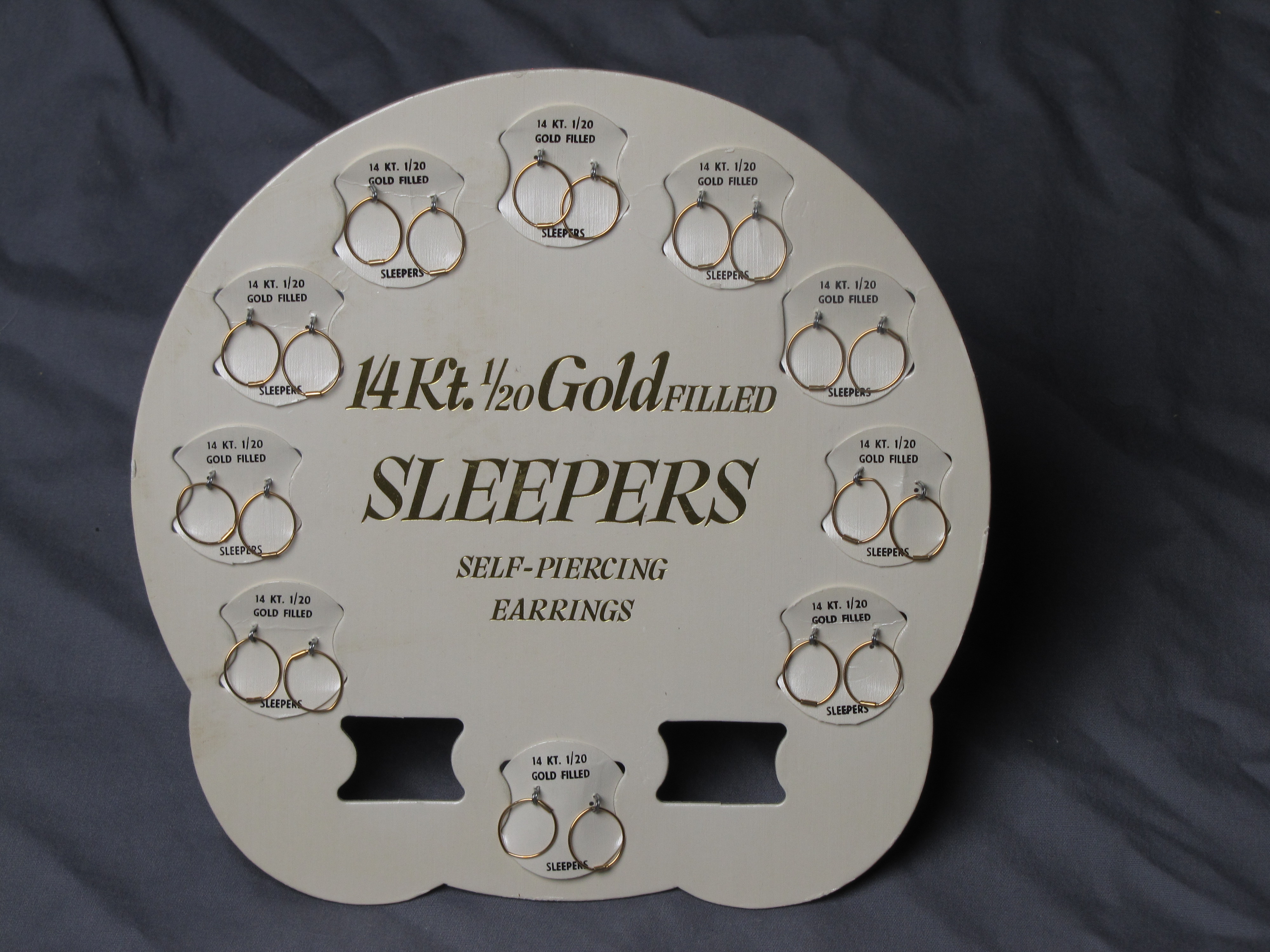
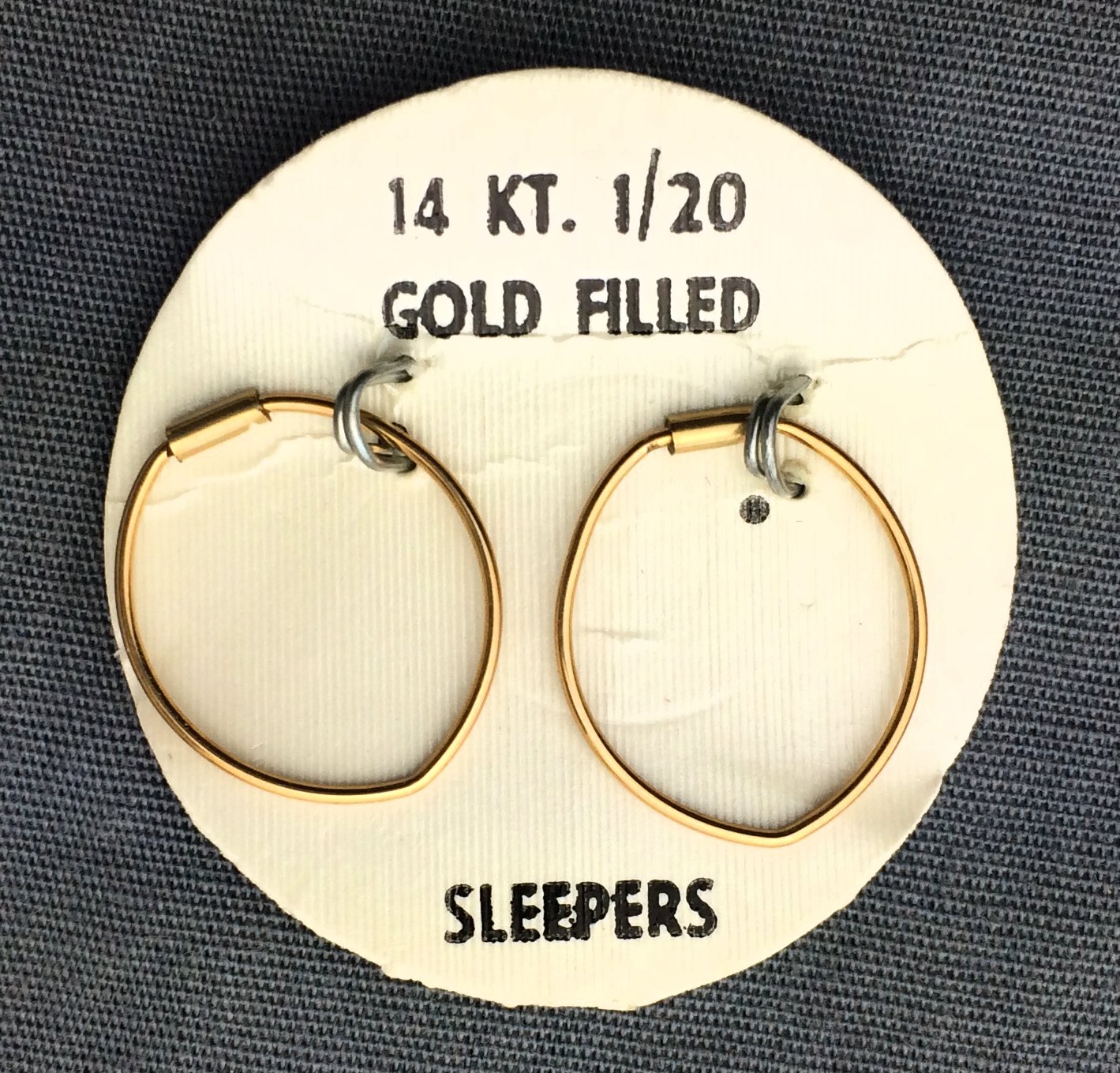
Also there were “trainer” earrings. Although Wikipedia says they were synonymous with sleepers, in reality they were to “train” your ears after being pierced with one of the removable needle professional methods, or if you used the pin and apple method at home. There’s not a enough tension in them to pierce an ear and they’re a lot thinner and thus easier to insert than regular earrings and 14K gold is less allergenic than cheap jewelry.
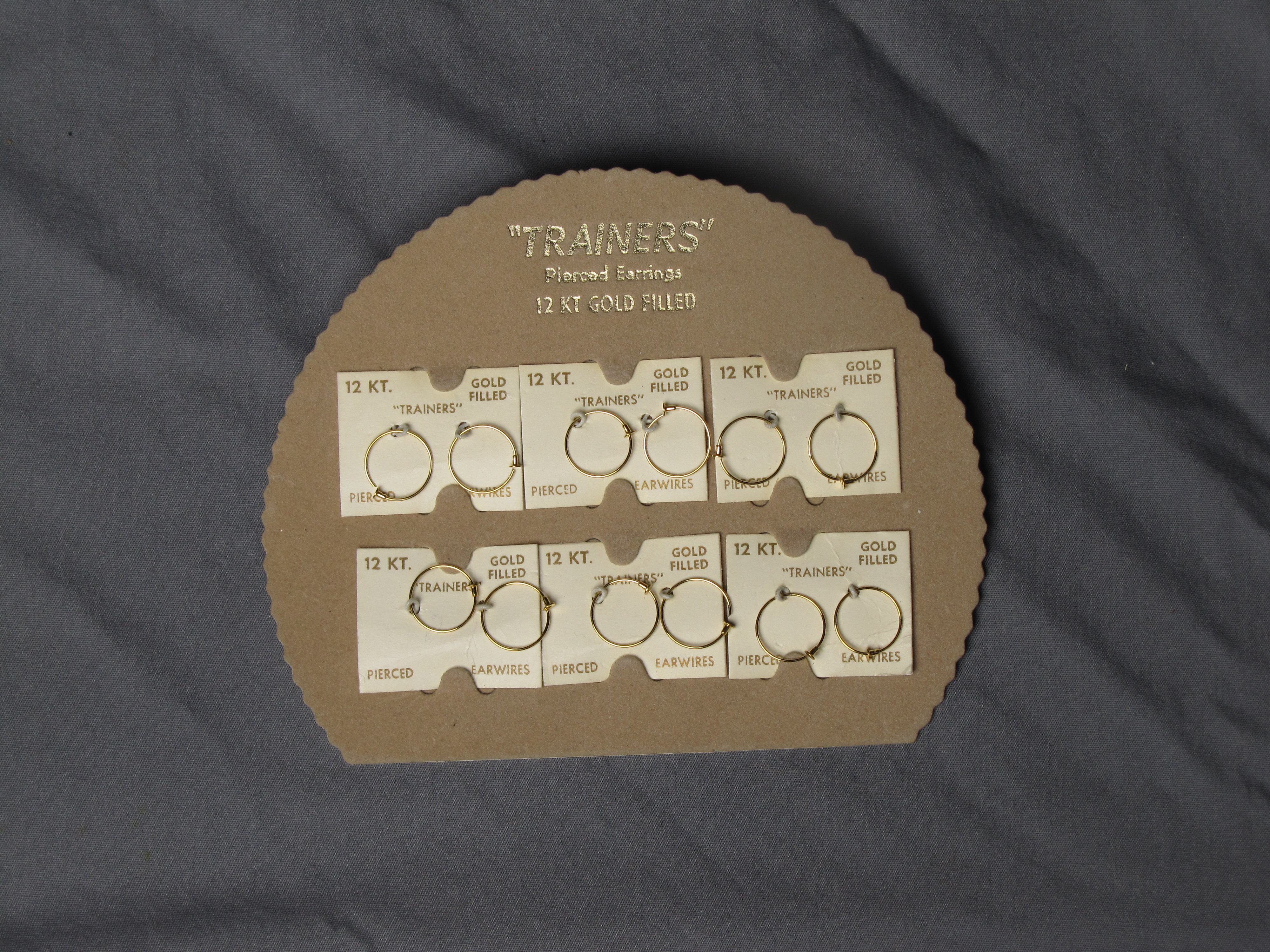
Studex and Inverness Self Piercing Kits
Studex and Inverness both developed kits for the do-it-yourself market in the early 1990s. Studex developed a cartridge for self-piercing that later was adapted for their commercial instruments , while Inverness already had a cartridge for their commercial instrument, so they made cheap plastic instruments to use it for home use.
Here’s the Studex kits, 1990s to today. The two on the left used the original self-piercing cartridges that have thicker duller posts the one on the right is the current product that uses the System 75 studs that are smaller and sharper. Note the cartridges with the exposed piercing studs to be shot in your ear are displayed prominently at first, and then they got more subtle about it. (Medisept was a marketing name of Studex for a short time).
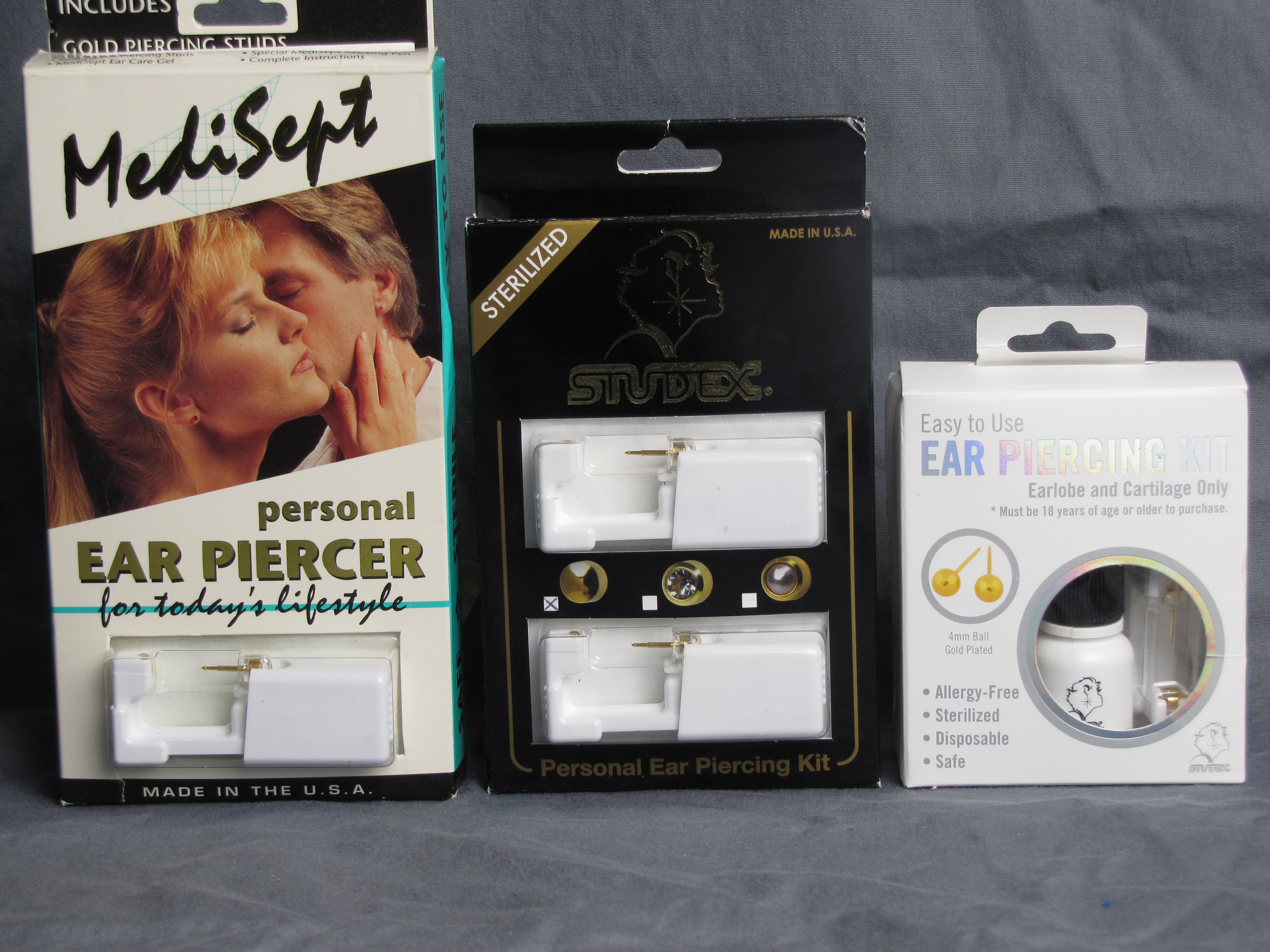
Here are the contents of the first two, they differ only in the name on the stuff.

And the third kit, which is much more upscale looking and comes with a wider variety of studs, now the thinner, sharper System 75 piercing studs. In practice though if you don’t like the selection in the kits you can buy any System 75 piercing studs you want.

The instructions have full color photographs, and there’s two round cards. One has aftercare instructions on front and back, and one they call the “Brave Kid Card” for your scrapbook that has the Studex log on front and then “I just had my ears pierced!” With spaces to fill in your name, date, and witnesses.
Here’s some of the Inverness Self-Piercing Kits over the years:

Here’s the business part of the early one on the left with a EXXL based disposable instrument; the entire instrument is factory sterile.

And the contents of the later kit. Some of their later kits have 14K gold piercing studs. This one is still gold-plated steel but includes the matching birthstone necklace.

The later kits from both manufacturers includes gloves. While you’re not going to catch some horrible disease from yourself, sometimes it’s a friend doing it and sometimes you might need to touch it to make sure the back is in place. Plus sometimes you can’t resist trying to grab at the pain when a piercing stud is shot in. Touching a fresh ear piercing with bare dirty hands is a definite no-no.
Also worth mentioning, these boxes that say “kit”, and are a lot shorter than the others.

These were mainly a packaging for the piercing stud cartridges for places like Walmart that didn’t want to sell their own ear care solution or print up their own aftercare guides. (Walmart would advertise “free ear piercing with purchase of a ‘kit'”). Notably these don’t contain any kind of piercing instrument and you can’t use them without it like Studex 75 cartridges. Walmart would sell you the box and a separately packaged disposable instrument (for another $5) if you insisted on taking it home. But more commonly you’d pay for the package, then sit down while the nice lady broke open the package, shot your ears, and then sent you home with the box (with aftercare instructions printed on it) and solution.
Current Ebay and Amazon ear piercing kits.
You can still buy “name brand” Studex, Inverness, and Coren professional and self-piercing kids on eBay and Amazon, but now that their patents have expired, you can by Chinese knock-offs of them.
Traditional Piercing Guns
These are knock-offs of the traditional piercing guns, variously the earlier all metal designs and the later plastic and metal designs.
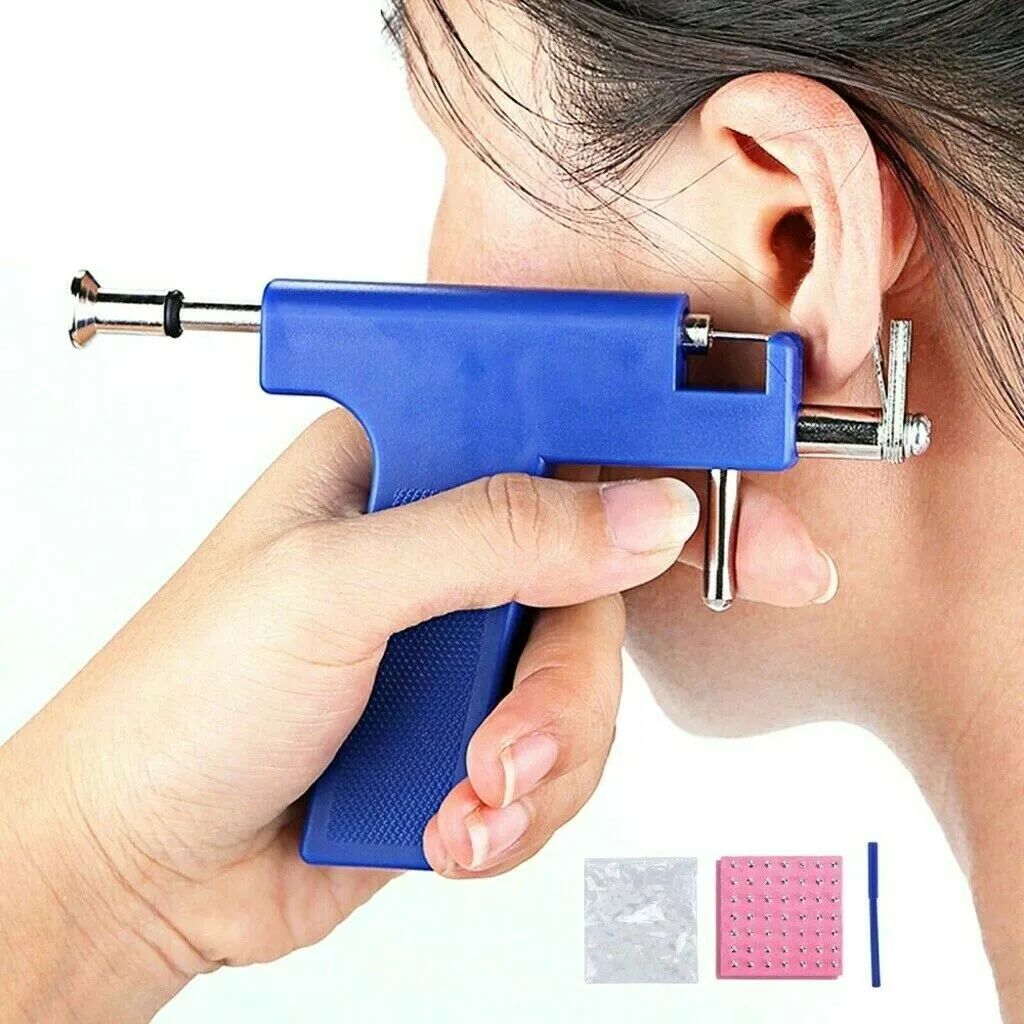
These do hurt a bit more because in addition to the pain of the piercing stud itself puncturing your earlobe, the plunger and clamp deliver a pretty vicious pinch. But the clamp also holds your ear perpendicular to the piercing stud, so it’s easy for the inexperienced to line it up and get it straight.
Cartridges
You also see these clones of the Studex cartridges. My criticism holds that they were never really designed for self-application, or application without the instrument, so they’re difficult to line up and require a lot of force to activate, which can mess up placement. But there’s also clones of the instruments on eBay too, you can get an instrument and some cartridges for $20, and this is what I recommend when going this route.

I’ve also seen these “long” cartridges. These are still somewhat awkward to use and line up, but do add springs to drive the stud through your earlobe, requiring less pressure to activate. I’ve seen both white and scary looking clear plastic versions.

My Thoughts and Where to Buy
So what do I think of these kits? If you insist on doing it yourself or having your bff come over and do it, using one of these is the way to go. They won’t hurt any more or less than having it done at a store since they use identical studs. The main problem I see is the skill of the operator, whether yourself or a friend. It’s hard to line it up straight looking in a mirror, and your friend might not be much better.
By contrast the nice lady at the jewelry store has been piercing ears all day and probably for many months with larger instruments and is more likely to get the placement correct and not freak out and jerk and get it crooked when it’s shot in. But at least they’re sterile, and unlike my experience trying to wiggle a dull stud through my ear, there’s no pushing it through slowly. Once you push hard enough to break the tab there’s no pushing it through slowly. The stud is going to pierce your ear, no hesitation, no take-backs.
I’ve had a few inquiries wondering where to buy these kits. As I mentioned Walmart used to sell the Inverness kits and the required separate instrument in their jewelry department if you insisted on doing it yourself. They’ve recently done a lot of reorganizing and downsizing their jewelry departments so I don’t know if that’s true anymore, or true at all locations. The Studex kits are available at Amazon and Studex and Inverness are available from eBay. Include the brand name in your search to filter out most of the cheap Asian imports and as from Walmart be aware the “short” Inverness boxes do not include an instrument.
